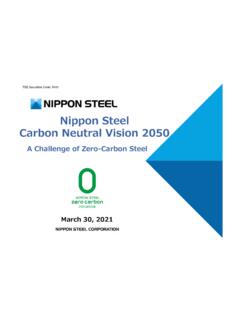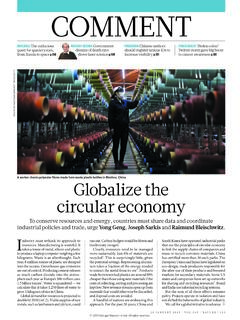Transcription of Greenhouse gas emissions of water supply and demand ...
1 Greenhouse gas emissions of water supply and demand management options Science Report SC070010. i Science Report - Greenhouse gas emissions of water supply and demand management options SCHO0708 BOFV-E-P. The Environment Agency is the leading public body protecting and improving the environment in England and Wales. It's our job to make sure that air, land and water are looked after by everyone in today's society, so that tomorrow's generations inherit a cleaner, healthier world. Our work includes tackling flooding and pollution incidents, reducing industry's impacts on the environment, cleaning up rivers, coastal waters and contaminated land, and improving wildlife habitats. This report is the result of research commissioned and funded by the Environment Agency's Science Programme.
2 Published by: Authors: Environment Agency, Rio House, Waterside Drive, Emma Reffold Aztec West, Almondsbury, Bristol, BS32 4UD Feifei Leighton Tel: 01454 624400 Fax: 01454 624409 Fida Choudhury Paul S Rayner (Halcrow Group Ltd). ISBN: 978-1-84432-921-2. Dissemination Status: Environment Agency July 2008 Released to all regions Publicly available All rights reserved. This document may be reproduced with prior permission of the Environment Agency. Keywords: water supply , demand management, carbon , The views and statements expressed in this report are Greenhouse gas, energy those of the author alone. The views or statements expressed in this publication do not necessarily Research Contractor: represent the views of the Environment Agency and the Halcrow Group Ltd Environment Agency cannot accept any responsibility for Burderop Park, Swindon, SN4 OQD.
3 Such views or statements. 01793 812479. This report is printed on Cyclus Print, a 100% recycled Environment Agency's Project Managers: stock, which is 100% post consumer waste and is totally Andy Howe, Environmental Policy chlorine free. water used is treated and in most cases Mike Briers, Science Department returned to source in better condition than removed. Science Project Number: Further copies of this report are available from: SC070010. The Environment Agency's National Customer Contact Centre by emailing: Product Code: SCHO0708 BOFV-E-P. or by telephoning 08708 506506. ii Science Report - Greenhouse gas emissions of water supply and demand management options Science at the Environment Agency Science underpins the work of the Environment Agency. It provides an up-to-date understanding of the world about us and helps us to develop monitoring tools and techniques to manage our environment as efficiently and effectively as possible.
4 The work of the Environment Agency's Science Department is a key ingredient in the partnership between research, policy and operations that enables the Environment Agency to protect and restore our environment. The science programme focuses on five main areas of activity: Setting the agenda, by identifying where strategic science can inform our evidence-based policies, advisory and regulatory roles;. Funding science, by supporting programmes, projects and people in response to long-term strategic needs, medium-term policy priorities and shorter-term operational requirements;. Managing science, by ensuring that our programmes and projects are fit for purpose and executed according to international scientific standards;. Carrying out science, by undertaking research either by contracting it out to research organisations and consultancies or by doing it ourselves.
5 Delivering information, advice, tools and techniques, by making appropriate products available to our policy and operations staff. Steve Killeen Head of Science iii Science Report - Greenhouse gas emissions of water supply and demand management options Executive summary Reducing Greenhouse gas emissions is one of the key challenges of our generation. The UK Government has recognised the necessity for significant reductions. The Stern Report, Energy White Paper and Climate Change Bill provide the scientific and legislative impetus to mitigate and adapt to the effect of emissions across all sectors of the UK. The water industry must play its part and reduce its Greenhouse gas footprint. water typically requires treatment prior to use and on its return to our environment. It is pumped and pressurised to reach our homes.
6 All of these activities require energy and therefore result in Greenhouse gas emissions . The water industry contributes per cent of annual UK Greenhouse gas emissions . However, the emissions that result from heating water in the home increases this figure to per cent. This project examines the difference in Greenhouse gas emissions associated with a variety of options for supplying water and using it more efficiently. We assess options for new supplies of water , working with an existing water supply network, plus methods and products to reduce and manage households' water demand . This study does not include any assessment of other environmental, social or economic costs and benefits. We provide an evidence base and framework to inform our understanding of water resource and carbon impacts, underpinning one of five modules of our new water resource strategy for England and Wales, planned to be published in December 2008.
7 This is also one report in a wider two-year project looking at the potential for energy efficiency and carbon reduction across the entire water industry. Throughout the report we refer to Greenhouse gas emissions as carbon dioxide equivalent (CO2e). The cost of CO2e follows the Defra Shadow Price of carbon guidance; 26 per tonne in 2008, thereafter rising by two per cent each year. This report does not include any assessment of other environmental, social or economic factors. We recognise that quantifying Greenhouse gas emissions is just one factor to be considered in the overall decision-making process. Our key findings 1. 89 per cent of carbon emissions in the water supply - use - disposal system is attributed to " water in the home" and includes the energy for heating water (excludes space heating), which compares with public water supply and treatment emissions of 11 per cent.
8 2. Simple demand management measures, particularly those which reduce hot water use, have significant potential to not only promote water and energy efficiency but also to reduce the carbon footprint of the water supply - use - disposal system. For example, moving to full water metering across England and Wales could reduce annual emissions by - million tonnes of carbon dioxide per year. Moving to full metering in areas of serious water stress could potentially reduce annual emissions by between - million tonnes CO2e per year. iv Science Report - Greenhouse gas emissions of water supply and demand management options 3. All supply side measures result in an increase in carbon emissions (we assume new schemes are implemented to meet rising demand rather than replacing existing assets).
9 There is often a wide range in carbon emissions associated with water supply schemes of a similar type, and therefore overlap between different types of schemes is common. For example, medium to large reservoirs and indirect effluent re-use can have similar carbon emissions per volume of water supplied, dependant on scheme design. To select the lowest carbon solution requires a scheme by scheme assessment. 4. Most demand management options, for example water metering, have low operational carbon emissions , the exception being retrofitting of household rainwater harvesting and greywater recycling to existing homes. Data concerning the energy use of these two techniques is scarce and requires further research. 5. Combinations of demand management options, even those including rainwater harvesting in new homes, offer larger water savings compared to individual water efficiency options and still compare favourably to supply side options in terms of overall lower carbon emissions .
10 6. Current legislation continues to require the sustainable management of rivers and groundwater. In some cases this will mean that water abstraction will need to be reduced to ensure a sustainable water environment, resulting in a reduction in the water available for supply . To offset this effect, companies are investigating alternative sources of water . Our work indicates this will increase carbon emissions overall. We believe that widespread implementation of demand management measures can offset or further reduce overall emissions , as well as reducing the need for some of these new supplies in the first For example an initial assessment using South East data indicates that the lowest carbon cost is delivered by the scenario which includes both demand management for two million homes and 18 new supply schemes, delivering a 14 per cent carbon cost saving compared to business as usual.
















